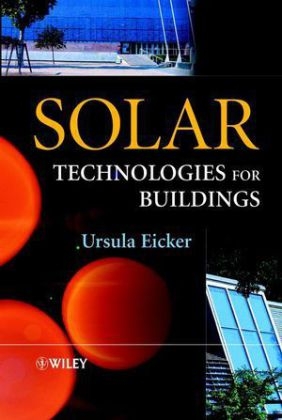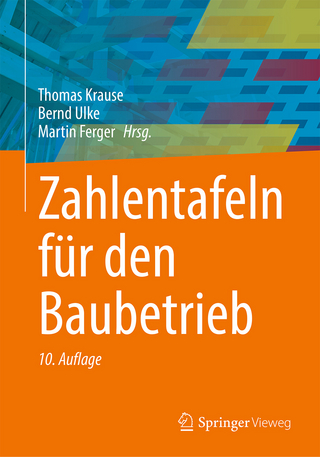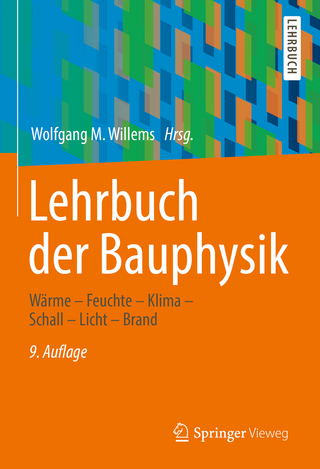
Solar Technologies for Buildings
John Wiley & Sons Inc (Verlag)
978-0-471-48637-4 (ISBN)
* A complete overview of solar technologies relevant to the built environment, including solar thermal energy for heating and cooling, passive solar energy for daylighting and heating supply, and photovoltaics for electricity production
* Provides practical examples and calculations to enable component and system simulation e.g. Calculation of U-values, I-V curve parameters and radiance distribution modelling
* Discusses the new trends in thermal energy use, including the architectural integration of collector systems, integrated ventilation photovoltaics facades and solar powered absorption cooling systems
* Coverage of cutting-edge applications such as active and passive cooling techniques and results from ongoing research projects
Ursula Eicker is a physicist who carries out international research projects on solar cooling, heating, electricity production and building energy efficiency at the University of Applied Sciences in Stuttgart. She obtained her PhD in amorphous silicon thin-film solar cells from Heriot-Watt University in Edinburgh and then worked on the process development of large-scale amorphous silicon modules in France. She continued her research in photovoltaic system technology at the Centre for Solar Energy and Hydrogen Research in Stuttgart. She set up the Solar Energy and Building Physics Research Group in Stuttgart in 1993. Her current research emphasis is on the development and implementation of active solar thermal cooling technologies, low-energy buildings and sustainable communities, control strategies and simulation technology, heat transfer in façades, etc. Since 2002 she has been the scientific director of the research centre on sustainable energy technologies (zafh.net) in BadenWürttemberg. She also heads the Institute of Applied Research of the University of Applied Sciences in Stuttgart, where building physicists, geoinformation scientists, mathematicians, civil engineers and architects cooperate. During the last 10 years Professor Eicker has coordinated numerous research projects on sustainable communities with renewable energy systems and highly efficient buildings. The largest projects include the European Integrated POLYCITY Project, a demonstration project on sustainable buildings and systems in Germany, Italy and Spain, and the European PhD school CITYNET on information system design for sustainable communities.
Preface ix
Abbreviations in the text xi
1 Solar energy use in buildings 1
1.1 Energy consumption of buildings 1
1.1.1 Residential buildings 2
1.1.2 Office and administrative buildings 4
1.1.3 Air conditioning 6
1.2 Meeting requirements by active and passive solar energy use 9
1.2.1 Active solar energy use for electricity, heating and cooling 9
1.2.2 Meeting heating energy requirements by passive solar energy use 12
2 Solar irradiance 13
2.1 Extraterrestrial solar irradiance 13
2.1.1 Power and spectral distribution of solar irradiance 13
2.1.2 Sun–Earth geometry 16
2.1.2.1 Equator coordinates 17
2.1.2.2 Horizon coordinates 20
2.1.2.3 Sun-position diagrams 22
2.2 The passage of rays through the atmosphere 24
2.3 Statistical production of hourly irradiance data records 26
2.3.1 Daily average values from monthly average values 27
2.3.2 Hourly average values from daily average values 31
2.4 Global irradiance and irradiance on inclined surfaces 34
2.4.1 Direct and diffuse irradiance 34
2.4.2 Conversion of global irradiance to inclined surfaces 35
2.4.2.1 An isotropic diffuse irradiance model 35
2.4.2.2 Diffuse irradiance model based on Perez 36
2.4.3 Measurement techniques for solar irradiance 39
2.5 Shading 39
3 Solar thermal energy 45
3.1 Solar-thermal water collectors 45
3.1.1 Innovations 45
3.1.2 System overview 46
3.1.3 Thermal collector types 47
3.1.3.1 Swimming pool absorbers 47
3.1.3.2 Flat plate collectors 47
3.1.3.3 Vacuum tube collectors 48
3.1.3.4 Parabolic concentrating collectors 48
3.1.4 System engineering for heating drinking-water 49
3.1.4.1 The solar circuit and hydraulics 49
3.1.4.2 Heat storage 55
3.1.4.3 Piping and circulation losses 60
3.1.5 System technology for heating support 61
3.1.6 Large solar plants for heating drinking water with short-term stores 63
3.1.6.1 Design of large solar plants 66
3.1.7 Solar district heating 68
3.1.8 Costs and economy 71
3.1.9 Operational experiences and relevant standards 73
3.1.10 Efficiency calculation of thermal collectors 74
3.1.10.1 Temperature distribution of the absorber 75
3.1.10.2 Collector efficiency factor F' 79
3.1.10.3 Heat dissipation factor FR 79
3.1.10.4 Heat losses of thermal collectors 83
3.1.10.5 Optical characteristics of transparent covers and absorber materials 92
3.1.11 Storage modelling 97
3.2 Solar air collectors 103
3.2.1 System engineering 105
3.2.2 Calculation of the available thermal power of solar air collectors 107
3.2.2.1 Temperature-dependent material properties of air 107
3.2.2.2 Energy balance and collector efficiency factor 108
3.2.2.3 Convective heat transfer in air collectors 109
3.2.2.4 Thermal efficiency of air collectors 117
3.2.3 Design of the air circuit 120
3.2.3.1 Collector pressure losses 120
3.2.3.2 Air duct systems 121
4 Solar cooling 123
4.1 Open cycle desiccant cooling 125
4.1.1 Introduction to the technology 125
4.1.2 Coupling with solar thermal collectors 128
4.1.3 Costs 128
4.1.4 Physical and technological bases of sorption-supported air-conditioning 129
4.1.4.1 Technology of sorption wheels 129
4.1.4.2 Air-status calculations 130
4.1.4.3 Dehumidifying potential of sorption materials 132
4.1.4.4 Calculation of the sorption isotherms and isosteres of silica gel 135
4.1.4.5 Calculation of the dehumidifying performance of a sorption rotor 140
4.1.5 The technology of heat recovery 143
4.1.5.1 Recuperators 143
4.1.5.2 Regenerative heat exchangers 148
4.1.6 Humidifier technology 152
4.1.7 Design limits and climatic boundary conditions 153
4.1.7.1 Demands on room temperatures and humidities 153
4.1.7.2 Regeneration temperature and humidity 153
4.1.7.3 Calculation of supply air status with different climatic boundary conditions 154
4.1.7.4 Limits and application possibilities of open sorption 155
4.1.8 Energy balance of sorption-supported air-conditioning 156
4.1.8.1 Usable cooling power of open sorption 156
4.1.8.2 Coefficients of performance and primary energy consumption 158
4.2 Closed cycle adsorption cooling. 162
4.2.1 Technology and areas of application 162
4.2.2 Costs 163
4.2.3 Operational principle 163
4.2.4 Energy balances and pressure conditions 165
4.2.4.1 Evaporator 166
4.2.4.2 Condenser 168
4.2.4.3 The adsorption process 169
4.2.4.4 Heating phase 172
4.2.4.5 The desorption process 172
4.2.4.6 Cooling phase 174
4.2.5 Coefficients of performance 175
4.3 Absorption cooling technology 177
4.3.1 The absorption cooling process and its components 178
4.3.1.1 Double-lift absorption cooling process 181
4.3.1.2 Evaporator and condenser 182
4.3.1.3 Absorber 183
4.3.1.4 Generator 185
4.3.2 Physical principles of the absorption process 185
4.3.2.1 Vapour pressure curves of material pairs 185
4.3.3 Refrigerant vapour concentration 189
4.3.4 Energy balances and performance figures of an absorption cooler 190
4.3.4.1 Ideal performance figures 190
4.3.4.2 Real performance figures and enthalpy balances 191
4.3.5 Absorption technology and solar plants 200
5 Grid-connected photovoltaic systems 201
5.1 Structure of grid-connected systems 201
5.2 Solar cell technologies 203
5.3 Module technology 203
5.4 Building integration and costs 204
5.5 Energy production and the performance ratio of PV systems 205
5.5.1 Energy amortisation times 206
5.6 Physical fundamentals of solar electricity production 207
5.7 Current-voltage characteristics 209
5.7.1 Characteristic values and efficiency 209
5.7.2 Curve fittings to the current-voltage characteristic 210
5.7.2.1 Parameter adjustment from module data sheets 216
5.7.2.2 Full parameter set calculation 220
5.7.2.3 Simple explicit model for system design 221
5.7.3 I-V characteristic addition and generator interconnecting 223
5.8 PV performance with shading. 225
5.8.1 Bypass diodes and backwards characteristics of solar cells 225
5.9 Simple temperature model for PV modules 228
5.10 System engineering 231
5.10.1 DC connecting 231
5.10.1.1 Cable sizing 231
5.10.1.2 System voltage and electrical safety 232
5.10.1.3 String diodes and short-circuit protection 232
5.10.2 Inverters 234
5.10.2.1 Operational principle 234
5.10.2.2 Electrical safety and mains monitoring 235
5.10.2.3 Inverter efficiencies 235
5.10.2.4 Power sizing of inverters 238
6 Thermal analysis of building-integrated solar components 243
6.1 Empirical thermal model of building-integrated photovoltaics 244
6.2 Energy balance and stationary thermal model of ventilated double facades 246
6.2.1 Heat transfer coefficients for the interior and facade air gap 250
6.3 Building-integrated solar components (U- and g-values) 254
6.4 Warm-air generation by photovoltaic facades 257
7 Passive solar energy 260
7.1 Passive solar use by glazings 260
7.1.1 Total energy transmittance of glazings 261
7.1.2 Heat transfer coefficients of windows 263
7.1.3 New glazing systems 265
7.2 Transparent thermal insulation 265
7.2.1 Operational Principle 266
7.2.2 Materials used and construction 270
7.2.2.1 Construction principles of TWD systems 270
7.3 Heat storage by interior building elements 271
7.3.1 Component temperatures for sudden temperature increases 274
7.3.2 Periodically variable temperatures 281
7.3.3 Influence of solar irradiance 286
8 Lighting technology and daylight use 288
8.1 Introduction to lighting and daylighting technology 288
8.1.1 Daylighting of interior spaces 289
8.1.2 Luminance contrast and glare 291
8.2 Solar irradiance and light flux 291
8.2.1 Physiological–optical basics 292
8.2.2 Photometric radiation equivalent 292
8.2.3 Artificial light sources. 294
8.3 Luminance and illuminance 295
8.3.1 Luminance and adaptation of the eye 299
8.3.2 Distribution of the luminous intensity of artificial light sources 300
8.3.3 Units and definitions 303
8.4 Sky luminous intensity models 304
8.5 Light measurements 307
8.6 Daylight distribution in interior spaces 308
8.6.1 Calculation of daylight coefficients 311
References 316
Index 320
| Erscheint lt. Verlag | 9.7.2003 |
|---|---|
| Verlagsort | New York |
| Sprache | englisch |
| Maße | 174 x 247 mm |
| Gewicht | 624 g |
| Einbandart | gebunden |
| Themenwelt | Technik ► Architektur |
| Technik ► Bauwesen | |
| Technik ► Elektrotechnik / Energietechnik | |
| ISBN-10 | 0-471-48637-X / 047148637X |
| ISBN-13 | 978-0-471-48637-4 / 9780471486374 |
| Zustand | Neuware |
| Haben Sie eine Frage zum Produkt? |
aus dem Bereich


